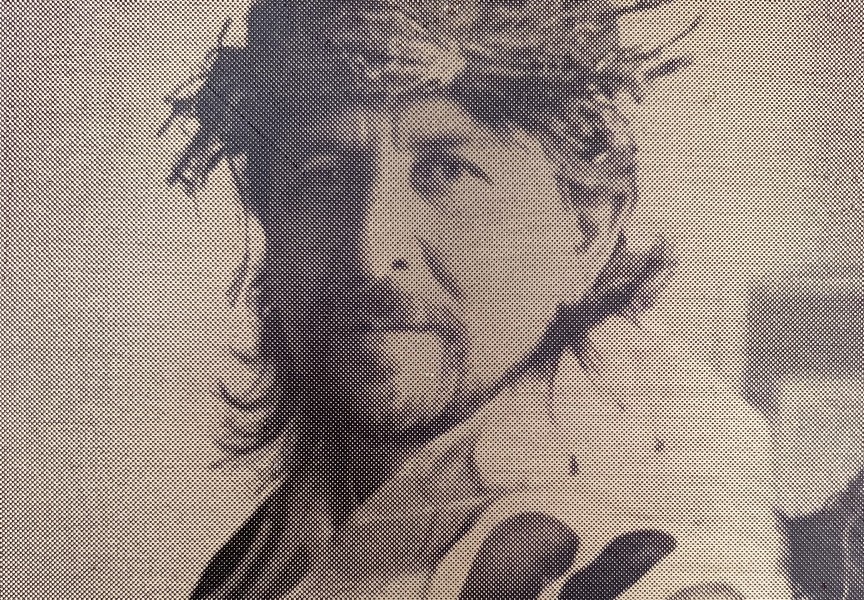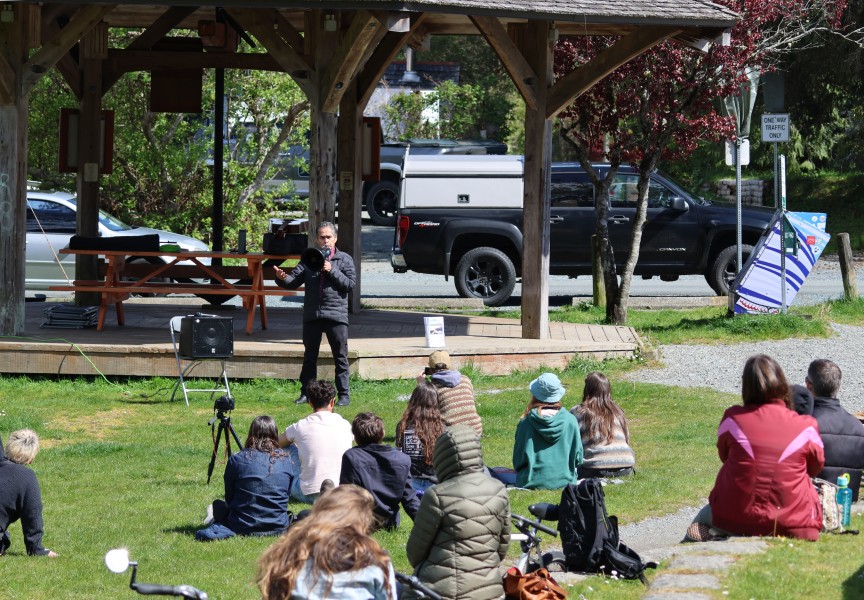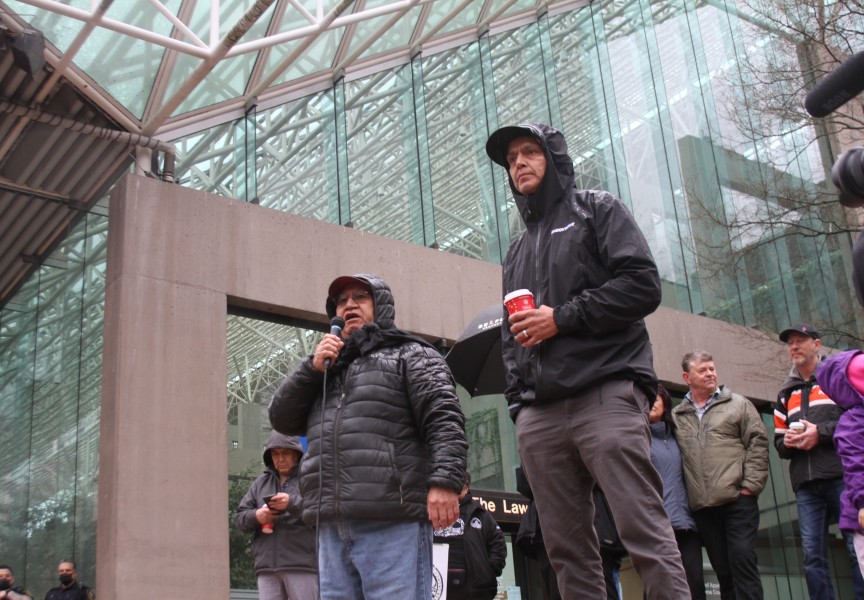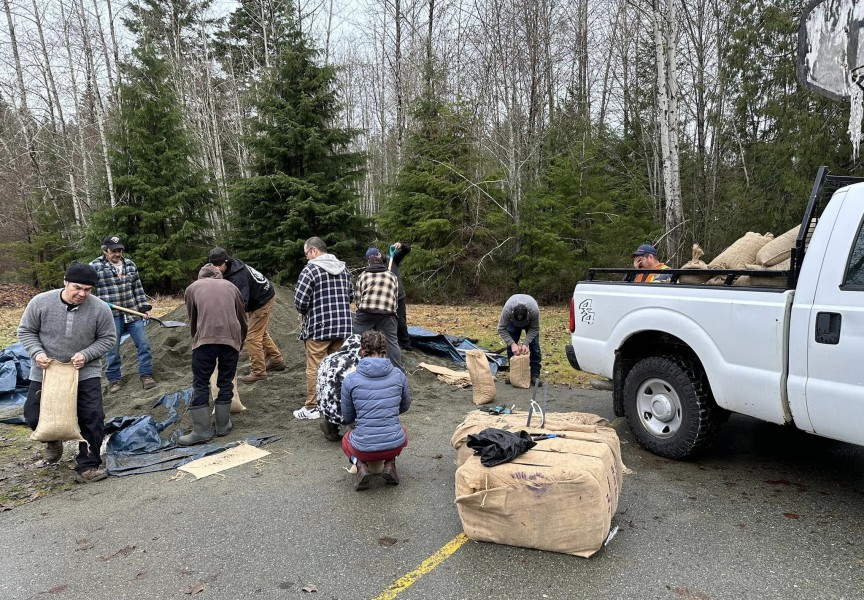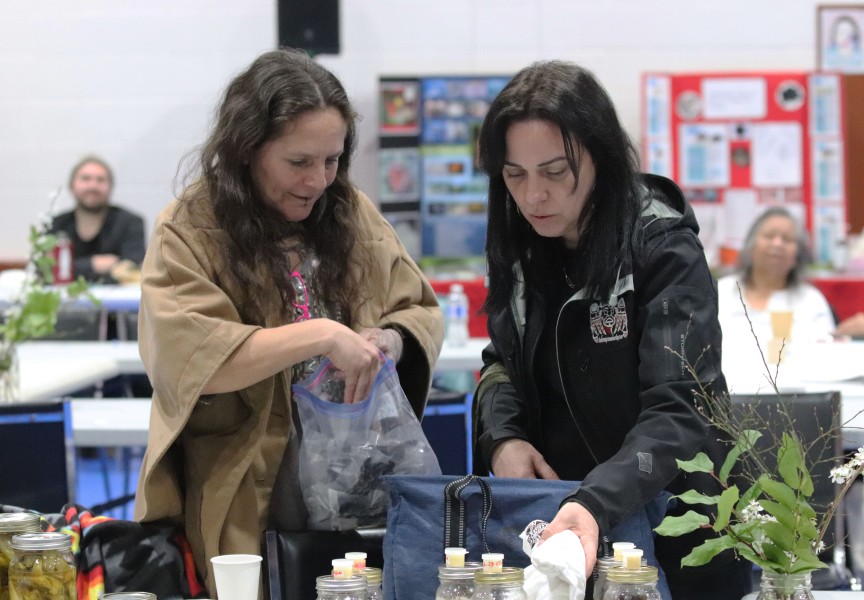World renowned Hesquiaht artist Tim Paul has given one of his masterpieces—a cedar totem pole—to the people of Tsilhqot’in in celebration of their protection of the spiritual site Teztan Biny (Fish Lake) from the mining proposal New Prosperity Project.
On the morning of Oct. 2, as the sun was rising over the mountains of the Alberni Valley, Paul, his family and guests gathered to take part in a ‘closing of the eyes’ ceremony. This is done to protect the pole and the people as it travels from one destination to another.
Linus Lucas performed a prayer chant over the totem pole before it was loaded onto a cube van for the long drive to Nemiah Valley, B.C.
A Tsilhqot’in delegation led by Chief Joe Alphonse traveled to Port Alberni to accompany the pole to its final home on the shores of Fish Lake.
The pole would be accompanied by some Nuu-chah-nulth people, Tsilhqot’in people and a documentary filmmaker.
Paul said the pole was a work in progress that started about two years ago.
The idea to give the pole to Tsilhqot’in people came after their chiefs Alphonse and Francis came to the Anietsachist pole raising in Tofino, B.C. in the summer of 2008.
Paul had carved that pole in memory of his ancestor Anietsachist and temporarily raised the pole for the public in Tofino in 2008.
Anietsachist and a man named Katkinna were wrongfully tried and convicted of murdering sailors. Hesquiaht oral history tells us, however, that the sailors had been shipwrecked on the coast and their bodies washed ashore. To be respectful, the Hesquiahts buried their remains above the beach. Aniesachist and Katkinna, however, were accused of murdering the sailors and were tried, brought back to Hesquiaht territory and hanged in front of the people.
“When we heard about your chief being hung inside his village, we had to be there when you raised that pole in his memory,” said Chief Alphose. He said his people went through a similar experience with six of their chiefs being hanged in Richmond, B.C.
His people, he said, were honoured to go Tofino to help raise that pole. And when it was raised they thought they were done.
“We didn’t know why the pole was taken down right away, and then we heard it was going to be raised in your home territory in a provincial park,” said Alphonse. “And I thought, ‘In a park? Is that allowed? I don’t know but we can’t let them have all the fun’.” They went along to Homis for the second pole raising.
According to Paul, the intention of his gift to Tsilhqot’in is to show support to his friends and to build alliances.
“The mining business was never going to give up,” Paul said, “but the Tsilhqot’in never wavered.”
“The whole idea behind this is to build support for them; we are allies because we are up against Canada to protect our resources,” said Paul.
The pole’s major feature is the first woman, noted for her strength and wisdom. There is also a sea serpent (snake in Tsilhqot’in culture), salmon, wolf and a depiction of a bear claw, because there wasn’t room for an entire bear figure.
Paul says both Nuu-chah-nulth and Tsilhqot’in have these symbols as an important parts of their ancient cultures, spirituality and stories.
Paul said it was important to him and his family to do this for the Tsilhqot’in as a way to pay respect and to share the wealth with their neighbors.
“It is a lesson in sharing and supporting—chaachim osa…meaning ‘I highly respect what you are doing’,” Paul explained.
“The art of giving is the greatest art of any in the universe; it is something our grandparents knew well. If you have compassion then you have everything and you will survive,” said Paul.
“Chaachim osa is what it is all about because it’s for our grandchildren and we need to keep building on that foundation,” Paul said.
Paul acknowledged other artists who worked on the pole, including Gordon Dick, Cecil Dawson and his daughter Sarah. The Dawsons, he said, put great effort into finishing the pole.
Paul also gave credit to his wife Monica, reminding Chief Alphonse that family support is very necessary.
And to show appreciation to Sarah Dawson for putting her energies into the pole as a young female artist, Paul bestowed a name on her, given from his family.
Chief Alphonse said he too was thankful and honoured that a woman had a hand in the beautiful artwork. He said women were held in high regard in Tsilhqot’in culture.
Cecil Dawson said it was a great honour to be part of this project and to help in supporting one another in this fight against Canada.
“It’s been said we feel alone in this fight,” said Chief Alphonse.
Taseko Mines and the people of Williams Lake were pushing for a mine and told the Tsilhqot’in they would never win, he continued.
“We believe in where we come from; we believe in the land. They tried to stop us two times but we won.
They want to go another round and we’re willing to go,” said Chief Alphonse.
He said his people went to the Assembly of First Nations and others seeking support for their case and they got it.
“As Indian Nations holding hands there is no beating us,” said Chief Alphonse.
He pointed out that his people from the interior and the coastal Nuu-chah-nulth-aht have one resource in common and that is the sockeye salmon that travels from Tsilhqot’in lakes to Nuu-chah-nulth waters.
With that, he presented Paul with smoked sockeye salmon, tobacco and some money to help with travel expenses. The tobacco, he said, is medicine – for the pure of heart.
Of the pole, Chief Alphonse said, “When it comes to our home we hope it will serve to awaken our spirits.”

